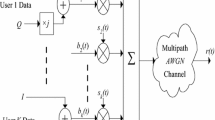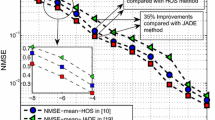Abstract
A new blind detection algorithm, based on fourth-order cumulant matrices, is presented and applied to the multiuser symbol estimation problem in direct sequence code division multiple access (DS-CDMA) systems. The blind detection is to estimate multiple symbol sequences in the downlink of a DS-CDMA communication system using only the received wireless data and without any knowledge of the user spreading codes. The proposed algorithm takes advantage of higher cumulant matrix properties to reduce the computational load and enhance the performance. Bit error rate simulations of this algorithm are performed for different numbers of users, signal-to-noise ratios, and numbers of symbols per user in comparison with the FastICA and RobustICA algorithms. The results show that the proposed algorithm outperforms both ICA-based detectors in estimating the symbol signals from the received mixed signals. Moreover, the proposed blind detector is computationally fast and exhibits high convergence speed in extracting user symbols.






Similar content being viewed by others
References
Z. Albataineh, F. Salem, New blind multiuser detection DS-CDMA algorithm using simplified fourth order cumulant matrices, in IEEE International Symposium on Circuit and System (ISCAS), (IEEE, 2013), pp. 1946–1949
Z. Albataineh, F. Salem, New blind multiuser detection DS-CDMA algorithm using H-DE and ICA algorithms, in 4th International Conference on Intelligent Systems Modelling and Simulation (ISMS), (IEEE, 2013), pp. 569–574
Z. Albataineh, F. Salem, Blind multiuser detection DS-CDMA algorithm on the fast relative newton algorithm, in textitWireless telecommunication symposium (WTS), (IEEE, 2014), pp. 1–5
Z. Albataineh, F. Salem, New blind multiuser detection DS-CDMA algorithm based on Extension of Efficient FAST Independent Component Analysis (EF-ICA), in 4th International Conference on Intelligent Systems Modelling and Simulation (ISMS), (ISMS, 2013), pp. 543–548
A. Bayati, S. Prakriya, S. Prasad, Semi-blind space-time receiver for multiuser detection of DS/CDMA signals in multipath channels. Inst. Eng. Technol. 153(3), 410–418 (2006)
A.J. Bell, T.J. Sejnowski, An information maximization approach to blind separation and blind deconvolution. Neural Comput. 7(6), 1129–1159 (1995)
J.F. Cardoso, On the performance of orthogonal source separation algorithms, in Proceedings of EUSIPCO, (1994a), pp. 776–779
J.-F. Cardoso, High-order contrasts for independent component analysis. Neural Comput. 11(1), 157–192 (1999)
J.-F. Cardoso, A. Souloumiac, Blind beamforming for non Gaussian signals. IEEE Proc.-F 140(6), 362–370 (1993)
S. Choi, A. Cichocki, S. Amari, Flexible independent component analysis. J. VLSI Signal Process. 26(1–2), 25–38 (2000)
A. Cichocki, S. Amari, Adaptive Blind Signal and Image Processing: Learning Algorithms and Applications (Wiley, New York, 2002)
P. Comon, C. Jutten (eds.), Handbook of Blind Source Separation Independent Component Analysis and Applications, (Academic Press, Oxford, 2010)
P. Comon, Independent component analysis, a new concept. Signal Process. (Special Issue on Higher-Order Statistics) 36(3), 287–314 (1994)
R.C. Delamare, R. Sampaio Neto, Blind adaptive code-constrained constant modulus algorithms for CDMA interference suppression in multipath channels. IEEE Commun. Lett. 9(4), 334–336 (2005)
M. Gupta, B. Santhanam, ICA based blind adaptive MAI suppression in DS-CDMA systems, in Taos Ski Valley, Proceedings of IEEE-DSP Workshop (IEEE, Taos Ski Valley, 2004), pp. 201–205
L. Hu, X. Zhou, L. Zhang, Blind multiuser detection based on Tikhonov regularization. IEEE Commun. Lett. 15(5), 482–484 (2011)
A. Hyvarinen, A.E. Oja, A fast fixed-point algorithm for independent component analysis. Neural Comput. 9(7), 1483–1492 (1997)
A. Hyvarinen, Fast and robust fixed-point algorithm for independent component analysis. IEEE Trans. Neural Netw. 10(3), 626–634 (1999)
A. Hyvarinen, E. Oja, Independent component analysis: algorithms and applications. Neural Netw. 13(48–55), 411–430 (2000)
A. Kachenoura, L. Albera, L. Senhadji, P. Comon, ICA: a potential tool for BCI systems. IEEE Signal Process. Mag. 25(1), 57–68 (2008)
T. Koivisto, V. Koivunen, Blind despreading of short-code DS-CDMA signals in asynchronous multi-user systems. Signal Process. 11(87), 2560–2568 (2007)
X. Liu, R.B. Randall, A new efficient independent component algorithm: joint approximate diagonalization of simplified cumulant matrices, in The 16th National Congress of Australian Institute of Physics, (Canberra, 2005)
D. Nion, L. De Lathauwer, A block component model-based blind DS-CDMA receiver. IEEE Trans. Signal Process. 56, 5567–5579 (2008)
E. Ollila, The deflation-based fastICA estimator: Statistical analysis revisited. IEEE Trans. Signal Process. 58(3), 1527–1541 (2010)
E. Oja, Z. Yuan, The fast ICA algorithm revisited: convergence-analysis. IEEE Trans. Neural Netw. 17(6), 1370–1381 (2006)
S.D. Parmar, B. Unhelkar, Separation performance of ICA algorithms in communication systems, in IMPACT’09, Multimedia, Signal Processingand Communication Technologies, (2009), pp. 142–145
P.-Y. Qiu, Z.-T. Huang, W.-L. Jiang, C. Zhang, Improved blind spreading sequence estimation algorithm for the direct sequence spread spectrum signals JIET. Signal Process. 2(2), 139–146 (2008)
H. Rutishauser, The Jacobi method for real symmetric matrices. Numer. Math. 9, 1–10 (1966)
F.M. Salam, G. Erten, The state space framework for blind dynamic signal extraction and recovery, Proceedings of IEEE International Symposium on Circuits and Systems (ISCAS’, 99), vol. 5, (IEEE, 1999), pp. 66–69
L. Shen, S. Li, F. Chen, J. Wei, Blind multi-user detection in DS-CDMA downlink under gaussian noise using independent component analysis, in 8th International Conference on Signal Processing, (Beijing, 2006), pp. 1–6
J.K. Tugnait, J. Ma, Blind multiuser receiver for space-time coded CDMA signals in frequency-selective channels. IEEE Trans. Wirel. Commun. 3(5), 1770–1780 (2004)
M.K. Tsatsanis, Z. Xu, Performance analysis of minimum variance CDMA receivers. IEEE Trans. Signal Process. 46(11), 3014–3022 (1998)
K. Waheed, K. Desai, F.M. Salem, Blind multi user detection in DS-CDMA systems using natural gradient based symbol recovery structures, in Proceedings of 4th International Conference on Independent Component Analysis and Blind Signal Separation, (2003), pp. 727–732
K. Waheed, K. Desai, F.M. Salem, Natural gradient based blind multi user detection in QPSK DS-CDMA systems, in Proceedings of IEEE-INNS Joint International Conference Neural Networks, vol 3, (IEEE, 2003), pp. 1862–1867
K. Waheed, F. Salem, Blind information-theoretic multiuser detection algorithms for DS-CDMA and WCDMA downlink systems. IEEE Trans. Neural Netw. 16(4), 937–948 (2005)
Y. Washizawa, Y. Yamashita, T. Tanaka, A. Cichocki, Blind extraction of global signal from multi-channel noisy observations. IEEE Trans. Neural Netw. 21(9), 1472–1481 (2010)
L. Xianhua, J.-F. Cardoso, R.B. Randall, Very fast blind source separation by signal to noise ratio based stopping threshold for the SHIBBS/SJAD algorithm. Mech. Syst. Signal Process. 24(7), 2096–2103 (2010)
C. Xu, G. Feng, K.S. Kwak, A modified constrained constant modulus approach to blind adaptive multiuser detection. IEEE Trans. Commun. 49(9), 1642–1648 (2001)
Y. Yao, H. Vincent Poor, Blind detection of synchronous CDMA in on-Gaussian channels. IEEE Trans. Signal Proc. 52(1), 271–279 (2004)
V. Zarzoso, P. Comon, R. Phlypo, A contrast function for independent component analysis without permutation ambiguity. IEEE Trans. Neural Netw. 21(5), 863–868 (2010)
V. Zarzoso, P. Comon, Optimal step-size constant modulus algorithm. IEEE Trans. Commun. 56(1), 10–13 (2008)
V. Zarzoso, P. Comon, Robust independent component analysis by iterative maximization of the Kurtosis contrast with algebraic optimal step size. IEEE Trans. Neural Netw. 21(2), 248–261 (2010)
V. Zarzoso, P. Comon, Robust independent component analysis, (2009) http://www.i3s.unice.fr/~mh/RR/2009/RR-09.02-V.ZARZOSO.pdf
X.X. Zhang, T.S. Qiu, Blind multiuser detection based on improved Infomax and Fast ICA, in 2nd International Conference on Advanced Computer Control, Shenyang, (2010), pp. 476–479
G. Zhou, Z. Yang, S. Xie, J.M. Yang, Online blind source separation using incremental nonnegative matrix factorization with volume constraint. IEEE Trans. Neural Netw. 22(4), 550–560 (2011)
Acknowledgments
We would like to thank the anonymous reviewers for their helpful comments and evaluation of this paper.
Author information
Authors and Affiliations
Corresponding author
Rights and permissions
About this article
Cite this article
Albataineh, Z., Salem, F. Robust Blind Multiuser Detection Algorithm Using Fourth-Order Cumulant Matrices. Circuits Syst Signal Process 34, 2577–2595 (2015). https://doi.org/10.1007/s00034-014-9944-9
Received:
Revised:
Accepted:
Published:
Issue Date:
DOI: https://doi.org/10.1007/s00034-014-9944-9




